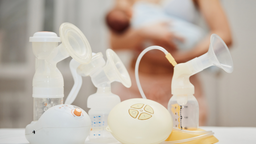Finding that your baby won’t latch on - either from birth or after some time nursing - can be a frustrating and often devastating experience. But new discoveries about babies’ innate instincts have given us new tools for helping bring a baby to the breast.
There are many reasons why a baby might refuse to latch on, such as tongue tie, birth injury, or nipple confusion. It’s best to consult with a trained breastfeeding support person such an International Board Certified Lactation Consultant (IBCLC) for a thorough assessment of your specific situation. You can search for an IBCLC here.
If you’ve identified the cause of your baby’s refusal to latch on - and even if you haven’t - it’s often a good idea to try using positions which help to trigger your baby’s innate reflexes.
How can you use Baby Led Breastfeeding and Laid Back Breastfeeding? Let's break it down.
BABY-LED BREASTFEEDING
Start with your baby in a calm state, preferably skin to skin on your chest. You can be in a reclined or upright position, though leaning back helps your baby get to the breast more easily. Hold your baby upright between your breasts (head beneath your chin), with support from underneath (not restricting her movement in any way). Then wait to see if she shows signs of interest in feeding. Try to relax and not pressure your baby into feeding. If she is ready, she’ll start squirming around, possibly bopping her head on your chest. Be ready to catch her if she squirms or lunges! Let her lean or lunge to one side or the other, and watch as she roots around for the nipple. Again, don’t pressure her, but gently guide her if she needs help. Then see if she latches on on her own. If she does, tell her what a great job she’s doing.
If your milk supply is a concern, you may want to compress your breast to squeeze a little extra milk out. This will provide a quick reward for her efforts and may induce her to stay on the breast longer. For a longer explanation, see this description from Dr. Christina Smillie.
LAID BACK BREASTFEEDING
Start in a comfortable, reclined position - not lying flat, but leaning back so that when your baby is on your chest gravity will hold him in position. Make sure your head and shoulders are well supported - you may need to adjust some pillows until you find a comfortable position. Place your baby on you (often on your chest, but any angle will do), and have your baby’s whole front touch your whole front. Let your baby’s cheek rest near your bare breast. She will move toward the breast in a similar way as that described above. If she needs help latching, help her. If she latches on, tell her what a good job she’s doing.
Read our full guide on laidback breastfeeding here.
SIGNS OF PROGRESS
How do you know if it’s working? For many babies who have never latched or who have had difficulty, a measure of success might be that your baby gets to the breast and doesn’t scream or cry! As small a step as this may sound, it’s a sign of good progress. If your baby does this a few times, she may next hold the breast in her mouth briefly before crying. And then she may take a few sucks. This is all a progression toward the goal of breastfeeding.



